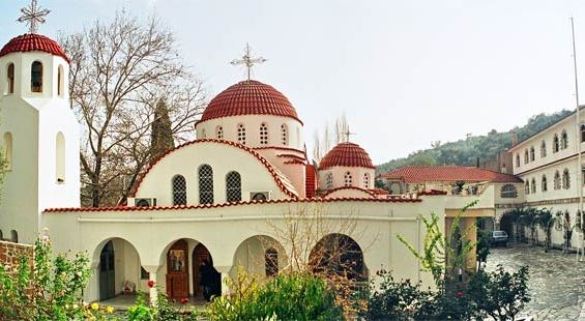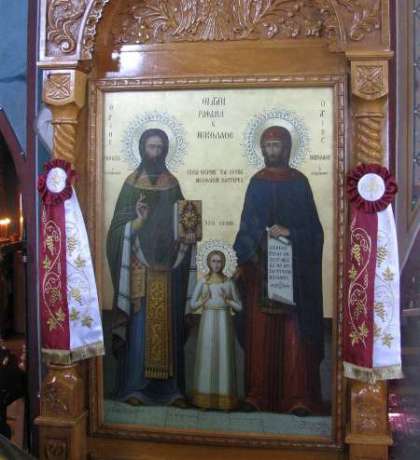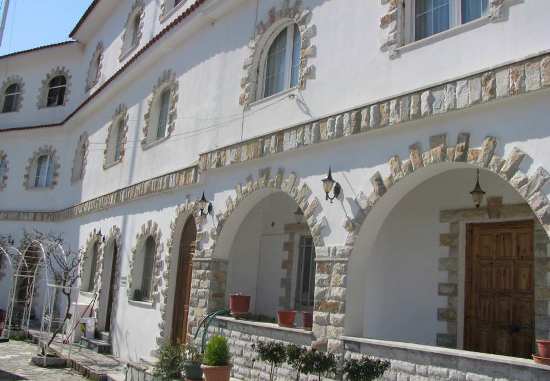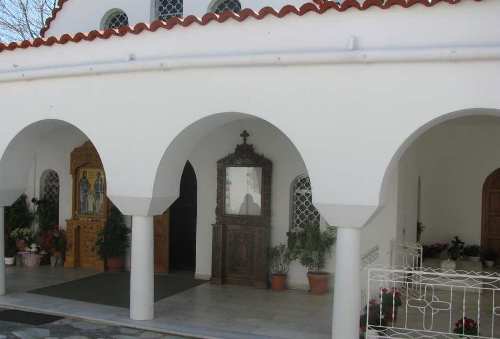
Over the spa town of Thermi stands the hill of Karyes; it was formerly known as “Panagia of Karya”, its ground was full of scattered hewn stones, while the air was filled with fragrance. The locals lit the vigil lamp daily and once a year, on Bright Tuesday, they celebrated the Divine Liturgy, as a traditional custom, although they didn’t know why.
The history of the miraculous finding of the relics of the saints
This hill also traditionally bears the name “Calogeros” (monk). It took this name from a supernatural vision. Numerous reliable people occasionally saw a monk wandering in the area, many times with a censer in his hands and then disappeared in a glow.
Not only Christians saw the monk, but also Turks. In 1917, Turkish landmasters who had fields of olive oils on Karyes hill assigned the investigation to the gendarme Eustratios Sitaras, to solve the mystery. After a while, the Turks themselves stopped the investigation, because Arif Effendi proclaimed the investigation unnecessary, because they had realized that the vision was of a supernatural origin.

On this holy place of Karyes was the olive field of the Turkish ruler Hasan Bey, where there was a chapel of the Theotokos. It only had an old kermes oak and a broken marble which they used as an altar. However, the inhabitants of Thermi traditionally used to climb up every Bright Tuesday and conduct a festive Liturgy, without any obstruction by the Turk owner of the estate. Thermiots and particularly the shepherds who grazed their flocks there didn’t stop seeing supernatural phenomena. They used to see the church being illuminated with heavenly light and they heard numinous bells and chants.
After the Asia Minor Catastrophe, Marangos refugee family possessed the Turkish olive field and, to fulfil a vow of their mother Angeliki, asked the permission from bishop Iakovos to build a church. During the excavation, on July 3, 1959, the workers headed by Doucas Tsolakis found a stone which, when they tried to take it out, went further deeper, as if it was deliberately placed there and finally it stopped on a marble slab. Under it they found a grave, where there was a fragrant human skeleton, while the skull rested on a round stone. However the skull was placed about thirty cm away from the body and the lower jaw was missing. In the mouth there was a Byzantine-era tile with a cross carved on it. The hands were crossed on the chest Immediately, they called the chaplain Fr. Efthymios Tsolos, the Diocese and an archaeologist named Charitonides, because apart from the grave several Byzantine-era marbles were found. The archaeologist asserted that this was an archaeological site and prohibited the excavations in a radius of 100 meters, not even on the roots of the olive trees.
From the day the grave of the unknown dead was found, many amazing supernatural phenomena began to take place, which left the workers astonished. Doukas Tsolakis gathered the bones and he carelessly placed them in a sack. Unexplainable clatter was heard from the bones, which give off a fragrance of incense. One of the worker, Leonidas Sideras, kicked off the sack and felt his whole limb benumbed, while Doukas Tsolakis, who irreverently tried to pick it up wasn’t able to move it because of great weight and frightened he made the sign of the cross. Afterwards, they invited the priest for a memorial, but he refused saying, “Whom should I pray for, since I don’t know him or his name?”
At night, the Saint presented himself to the priest and various other people and revealed that he is named Raphael and he comes from Ithaca island. He presented himself to young and old, men, women and children, pious and disrespectful alike, at times like a priest, at times in episcopal vestments, at times like an ordinary monk. During the same night, many unrelated people had the same dream, where he told them: “I am the Holy Hieromonk Martyr Raphael; the bones found in Karyes are mine. I suffered martyrdom under the Turks on April 9, 1463. I am the monk you saw year after year.” And the visions continued…
Saint Raphael’s story according to the revelations
Saint Raphael’s secular name was George Laskarides. His father Dionysios and his mother Maria were very devout people and gave George a Christian upbringing and great education. At a young age, he served as an officer for a short period, and then he was tonsured a monk and ordained a priest, taking the name Raphael. He served as a chaplain and a preacher in Saint Demetrios Loumpadiaris church, in Acropolis, Athens, and then he became an archimandrite and chancellor at the Ecumenical Patriarchate of Constantinople. Indeed, as a protector of Orthodoxy, he didn’t accept to participate in the discussions for a Union with the Western Church.
Because of his great education and experience, the Patriarchate sent him on a mission to France and there, at Morlée, he met the young student Nicolaos, scion of a rich family, son of a notary from Thessaloniki, wherefrom he was sent to study at a French university. The historical research has proved that in the 15th century, a few years before the Fall of Constantinople, the Ecumenical Patriarchate used to send educated and zealous priests to theological congresses in France. Morlée is a city of France with great religious history, as shown by churches built in the 5th and 6th century.
Therefore, Archimandrite Raphael first met Nicolaos in Morlée. Touched by the Christian teachings, the young student abandoned the worldly life and followed him. He returned to Greece, he embraced the monastic habit and soon he was ordained a deacon. Moreover, he became a faithful and dedicated partner and thence they never separated.
When Constantinople was conquered by the Turks in 1453, they happened to be in Thrace. In 1454, together with other refugees they fled from the port of Alexandroupolis to Lesbos island that was still free. A small boat brought them to the haven of Thermi. Straight away they requested information for any hermitage around, in order to retreat there and lead a monastic life, and they were guided to the Nativity of the Theotokos, that once was a convent but was destroyed by pirates in 1235. All thirty nuns of the convent had suffered martyrdom along with their abbess Olympia, who was greatly tortured, since the pirates nailed her alive on her skull and body.
The monasterial compound lied on the hill of Karyes, over Thermi, 14 km from Mytilene. In 1433, a pious woman, named Melpomene, abiding by a vow of her to Theotokos who had miraculously cured her child, dedicated part of her fortune to rebuild the monastery
There was only a monk there named Rubim and gradually a small brotherhood was formed there under the abbacy of Saint Raphael, which lived there in peace and concord for nine years. But in 1462, Mehmed II the Conqueror took over the island after a siege of 17 days.
Initially, Turks did not disturb the monastery. But after six months, on April 1463, during the Holy Week, a movement broke out and Christians ascended to Karyes to hide, for fear of the Turks’ anger. The Greek teacher Theodoros and the leader of the community Basilios also ascended there to hide in the monastery.
On Great Thursday, Saint Raphael conducted the Divine Liturgy for the last time. On Great Friday, Turk came to the monastery, arrested abbot Raphael, deacon Nicolaos, the teacher and the community leader’s family. The other Christians managed to flee to the mountain.
The Turks started torturing them variously to make them confess where the other people were hiding. In front of her parents’ eyes, who were tied on a walnut tree, they cut off the hand of Irene, the twelve-year-old daughter of the community leader and afterwards she was put in a crock and burned alive. Leader Basilios and teacher Theodoros were inhumanly slain.
Saint Irene’s mother was holding her baby in her arms. The Turks grabbed it, threw it down and trampled it. The leader’s niece Helen, 15, was abused and spanked horribly until she died.
Saint Raphael was bludgeoned until he was paralyzed and suffered many tortures. They dragged him violently on the rocks from his hair and beard. They hit him with cruelty, they speared him and eventually, on Bright Tuesday, hanged him upside down on a walnut tree and jagged him on his mouth, cutting his jaw off.
Saint Nicolaos was tied on a walnut tree and, after having seen his beloved abbot jagged, he had a heart attack speared by the Turks. It was on April 9, 1463. Afterwards they put fire on the monastery and left.
Next day, some pious Christian women, the caretaker Akindynos, the village priests and the third monk, who had survived, secretly buried the martyrs, the abbot under the ruins of the burnt Church and the others in the yard.
In the visions, Saint Raphael also indicated the exact places of the graves of the other martyrs. The jar, where little Irene was tortured, was found on March 3, 1960, teacher Theodoros’s grave on January 12, 1961, Basilios’s and Irene’s graves as well as Saint Irene’s incinerated relics on May 12, 1961, whereas one week before, the ancient Church with frescoes on the collapsed walls and a red tiled floor were found.
Finally, in late August 1962, the grave of the abbess Olympia, who martyred on May 11, 1235, was found. 3 long nails were found in her skull and 24 ones in her body, which are today kept together in the reliquary with her relics.
Therefore, the archaelogical hoe verified everything. Then the inhabitants of Thermi realized the meaning of their traditional annual celebration on the hill of Karyes; it was the day of the Saint’s martyrdom.
The investigation proved to everybody’s amazement, that the Easter of the year 1463 fell on April 7. The saints’ memory is now celebrated annually on Bright Tuesday.
The monastery
Once Metropolitan Iakovos realized that these revelations were verified, he wanted to establish a convent, which was reconstituted and recognized, 500 years after the drama of Karyes (1463- 1962). This is the third monastery in the place after those of Saint Raphael and Saint Olympia.

The monasterial complex, receiving thousands of pilgrims each year, consists of: the Catholicon in honor of Saint Raphael, two wings of 30 cells for the nuns, a very big reception hall, two big guesthouses for the tired visitors, a two-storey gallery of Greek painters and a big church of Saint Magdalene.

Tel.: (+30) 2251 071 259




